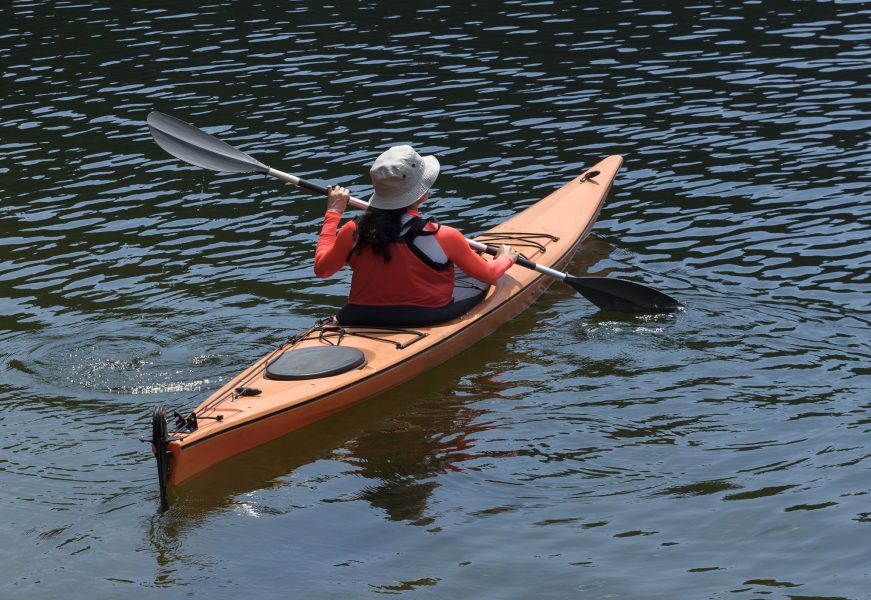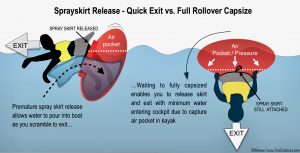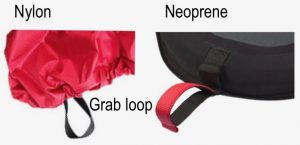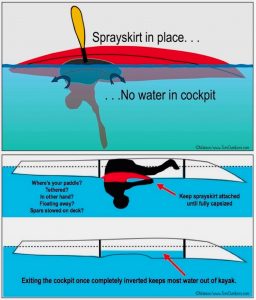
Image by Paya Mona, Shutterstock
While the popularity of kayaking has grown to include sit-on-top fishing platforms and recreational boats with huge, open cockpits, the use of sprayskirts on more traditional kayaks should be considered an important safety procedure among paddlers.
The primary purpose of a sprayskirt (a skirt-like garment worn by the paddler), is to be attached to the kayak cockpit’s coaming to seal that opening to prevent water from entering the boat. The firm, water tight seal makes the paddler and their boat one cohesive, water-impenetrable unit. In the event of waves crashing over the deck or a complete capsize, this seal prevents water from entering the interior of the boat. Excessive water sloshing around inside a boat adds weight and can severely affect the center of gravity and stability of the boat.
Because it needs to be snug to be effective, some paddlers fear that the spray skirt will slow down or prevent their exit should they capsize. This often results in the paddler frantically kicking free or grabbing the sprayskirt and scrambling out of the kayak as soon as a tip-over is evident. However, once that sprayskirt is removed, water rushes into the now unsealed, open cockpit, flooding the interior as the boat tips over.

Illustration by Tom Watson
A better way to make the sprayskirt work to your advantage during a capsize is to take a breath and simply go with the motion, and roll upside down completely — with the spray skirt still firmly in place. Once over, a quick yank on the sprayskirt’s grab loop (if fitted properly), will release the skirt’s grip on the coaming, allowing the paddler to push out and swim free of the kayak and up to the surface – all in just a few sec-onds.
Because the skirt’s seal isn’t broken until the kayak is completely over, very little water spills into the boat. The air pressure within the hull keeps water out when the sprayskirt is released after the boat is overturned. This aids in recovery techniques to get the boat upright without the extra weight and instability from a boat filled with excess water.
Sprayskirts are typically made from either nylon or neoprene and can be loose fitting or more elastic and snug. All are secured on top around the lower chest area by a torso tube-like upper section (with either cinch cord/elastic or suspenders) together with the waist seam at the bottom of the tube. The torso/waist section is then attached to a broad, horizontal panel shaped like the cockpit opening and held in place by an elastic band around the cockpit’s rim or coaming.

Image by Tom Watson
The forward end of the sprayskirt will have a grab loop that helps pull the skirt tight for attachment. A quick, upward and back tug on that same loop, releases the sprayskirt instantly.
Other advantages of a sprayskirt include a barrier to keep out cold, a sun shade for upper legs, and a platform for sorting small gear items (attaching fishing lures, eating snacks, etc).
If you are considering extended kayak trips or paddling across bigger bodies of water, include a spray skirt as part of your primary paddling gear. Spend some time in the water practicing capsizing, releasing the sprayskirt at different stages of tipping over.

Illustration by Tom Watson
Learn how to adjust it so your sprayskirt is easy to attach, yet quick to release, and see just how easy it is to remove it.
It’s all part of being a safe kayak paddler. Be Smart; Be Safe; Have Fun!
Tom Watson is an award-winning outdoor safety and skills columnist and author of guide books on tent camping, hiking and self-reliant survival techniques. His website is www.TomOutdoors.com.
 Your Privacy Choices
Your Privacy Choices